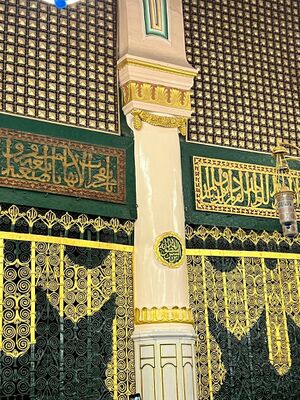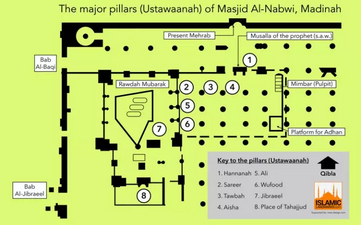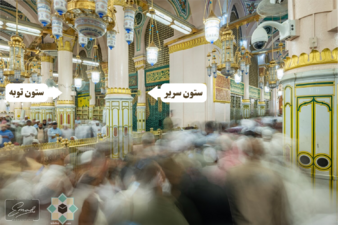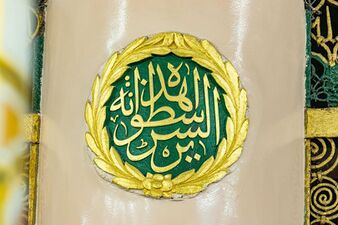Al-Sarir pillar: Difference between revisions
Pourghorbani (talk | contribs) |
m Text replacement - "<gallery>" to "<gallery mode="packed" heights="150px">" |
||
| (8 intermediate revisions by 2 users not shown) | |||
| Line 52: | Line 52: | ||
| map description = | | map description = | ||
}} | }} | ||
'''Al-Sarīr pillar''' is one of the [[ | '''The Al-Sarīr pillar'''' is one of the pillars in the [[Masjid al-Nabi]] (Prophet's Mosque), where the [[Prophet Muhammad]] (S) performed ''itikaf'' (spiritual retreat). This pillar became one of the supports of the Prophet’s tomb during the renovation of the Prophet’s Mosque carried out by the Mamluk Sultan Baibars. Since that time, access to the pillar for blessings has been restricted for worshippers. According to some narrations, seeking blessings from this pillar is recommended. | ||
==Location== | ==Location== | ||
he Al-Sarīr Pillar in the Prophet’s Mosque is located within the area of [[Rawdat al-Nabi]], to the east of the Pillar of Repentance.<ref>Samhūdī, ''Wafāʾ al-wafā'', vol. 2, p. 184; Shurrāb, ''Al-Ma ʿālim al-athīra'', p. 40.</ref> It is the first pillar on the side of the ''qibla'' (direction of prayer) and is adjacent to the western wall of the Prophet’s chamber.<ref>Qāʾidān, ''Tārīkh wa āthār-i Islāmī-i Makka wa Madīna'', p. 193. </ref> | |||
==Reason for naming== | ==Reason for naming== | ||
The | The Al-Sarīr Pillar is named as such because, during his days of Iʿtikāf (spiritual retreat), the Prophet would place his bed, made of palm leaves and wood or matting beside it.<ref>Ibn Zabāla, ''Akhbār al-madīna'', p. 103; Maṭarī, ''Al-Taʿrīf bimā ʾanasat'', p. 91; Najjār, ''Al-Durra al-thamīna'', p. 298.</ref> He would rest there during his retreat and sleep next to it when he needed to rest.<ref>Sayyid al-Wakīl, ''Al-masjid al-nabawīī ʿabar tārīkh'', p. 53; Yamānī, ''Mawsūʿa makka al-mukarrama wa al-madina al-munawwara'', vol. 2, p. 430.</ref> | ||
==Is Sarir | |||
[[ | ==Comparison with Al-Tawba Pillar== | ||
'''Is the Sarir Pillar the Same as the Al-Tawba Pillar?!''' | |||
Local historians of [[Medina]], such as [[Ibn Zubala]], [[Ibn Najjar]], and [[Matari]], did not introduce the "Sarīr Column." They only mentioned that during the days of I'tikaf (spiritual retreat) in Ramadan, the Prophet’s bed was placed between the Tawbah (Repentance) Column and a lamp near his grave,<ref>Ibn Zabāla, ''Akhbār al-madīna'', p. 103</ref> or near the Tawbah, Column<ref>Najjār, ''Al-Durra al-thamīna'', p. 298.</ref> or behind it from the eastern side.<ref>Maṭarī, ''Al-Taʿrīf bimā ʾanasat'', p. 91.</ref> This adds to the reasoning why some scholars have equated the Sarīr Column with the Tawbah Column due to their proximity in these reports.<ref>Ansārī, ''ʿImārah wa tawsiah al-masjid al-nabawīī'', p. 71.</ref> | |||
But the accurate interpretation suggests that the Prophet’s resting place was occasionally positioned adjacent to the [[Tawbah Column]] ([[Repentance Pillar]]), while at other times, it was situated beside the Sarīr Column.<ref>Ansārī, ''ʿImārah wa tawsiah al-masjid al-nabawīī'', p. 72; Yamānī, ''Mawsūʿa makka al-mukarrama wa al-madina al-munawwara'', vol. 2, p. 430.</ref> According to historians [[Ayoub Sabri Pasha]] and [[Ahmad bin Abdul-Hamid]], prior to the expansion of [[Masjid al-Nabawi]] following the Battle of [[Khaybar]], the Prophet would observe [[I'tikaf]] (spiritual retreat) near the Tawbah Column. Following this expansion, the location of his I'tikaf was relocated to the area near the Sarīr Column.<ref>Ṣabrī Pāshā, ''Mawsūʿa mirʾāt al-ḥaramayn'', vol. 3, p. 235-236; ʿAbd al- Ḥamīd, ''ʿUmda al-akhbār'', p. 99-100.</ref> | |||
==Inaccessibility of the Sarir Pillar for Pilgrims== | |||
During the reconstruction of [[Masjid al-Nabi]] under the reign of [[Malik al-Zahir Baybars]] (825–842 AH) of the [[Mamluk dynasty in Egypt]], significant changes were made to the structure of the mosque. One notable alteration involved the Sarir Pillar, which holds historical and religious significance. This reconstruction led to half of the Sarir Pillar being enclosed within the shrine of the [[Prophet Muhammad]] (S).<ref>Samhūdī, ''Wafāʾ al-wafā'', vol. 2, p. 184.</ref> As a consequence of this architectural modification, the Sarir Pillar, which was once accessible to pilgrims seeking blessings, is no longer within reach.(R: 825-842 AH/ 1422- 1438-9) of the Mamluks of Egypt,<ref>Samhūdī, ''Wafāʾ al-wafā'', vol. 1, p. 268.</ref> it is not possible for pilgrims to bless it. | |||
The enclosure of the pillar has effectively restricted the physical interaction and veneration practices that pilgrims historically performed. The reconstruction efforts, while aimed at preserving and enhancing the mosque, inadvertently limited direct access to this revered relic. | |||
==Virtue and Significance== | |||
== | Inscribed on the Sarir Pillar is the phrase "هذه اسطوانة السریر" ("This is the Sarir Pillar").<ref>Ṣabrī Pāshā, ''Mawsūʿa mirʾāt al-ḥaramayn'', vol. 3, p. 235-236</ref> According to several narrations, it is considered meritorious to seek blessings from this pillar. Despite the limited access imposed by historical reconstructions, the spiritual significance of the Sarir Pillar endures, highlighting its esteemed status within the religious traditions of Islam. The practice of seeking blessings from the pillar underscores the deep reverence and spiritual connection that the faithful maintain with this sacred site.<ref>Amīnī, ''Al-Ghadīr'', vol. 5, p. 124.</ref> | ||
==Gallary== | ==Gallary== | ||
<gallery> | <gallery mode="packed" heights="150px"> | ||
file:نقشه مسجدالنبی و ستونهای آن.webp|The map of [[Masjid al-Nabi]] where number 2 shows the location of the Sarir pillar. | file:نقشه مسجدالنبی و ستونهای آن.webp|The map of [[Masjid al-Nabi]] where number 2 shows the location of the Sarir pillar. | ||
file:ستون حرس و ستون سریر.png|Sarir pillarnext to [[Haras pillar]]. | file:ستون حرس و ستون سریر.png|Sarir pillarnext to [[Haras pillar]]. | ||
Latest revision as of 07:09, 22 August 2025
 | |
| General Information | |
|---|---|
| Other Names | pillar of I'tikaf |
| Place | Medina, Masjid al-Nabi |
| History | |
| Events | Prophet would spread his bed next to this pillar during I'tikaf.. |
| Current State | |
| Status | The Sarir pillar is located on the eastern side of the al-tawba pillar, and the first pillar from the Qibla and connected to the western wall of the Prophet's Room. This pillar was not accessible to pilgrims since the time of Baybaras. |
The Al-Sarīr pillar' is one of the pillars in the Masjid al-Nabi (Prophet's Mosque), where the Prophet Muhammad (S) performed itikaf (spiritual retreat). This pillar became one of the supports of the Prophet’s tomb during the renovation of the Prophet’s Mosque carried out by the Mamluk Sultan Baibars. Since that time, access to the pillar for blessings has been restricted for worshippers. According to some narrations, seeking blessings from this pillar is recommended.
Location
he Al-Sarīr Pillar in the Prophet’s Mosque is located within the area of Rawdat al-Nabi, to the east of the Pillar of Repentance.[1] It is the first pillar on the side of the qibla (direction of prayer) and is adjacent to the western wall of the Prophet’s chamber.[2]
Reason for naming
The Al-Sarīr Pillar is named as such because, during his days of Iʿtikāf (spiritual retreat), the Prophet would place his bed, made of palm leaves and wood or matting beside it.[3] He would rest there during his retreat and sleep next to it when he needed to rest.[4]
Comparison with Al-Tawba Pillar
Is the Sarir Pillar the Same as the Al-Tawba Pillar?! Local historians of Medina, such as Ibn Zubala, Ibn Najjar, and Matari, did not introduce the "Sarīr Column." They only mentioned that during the days of I'tikaf (spiritual retreat) in Ramadan, the Prophet’s bed was placed between the Tawbah (Repentance) Column and a lamp near his grave,[5] or near the Tawbah, Column[6] or behind it from the eastern side.[7] This adds to the reasoning why some scholars have equated the Sarīr Column with the Tawbah Column due to their proximity in these reports.[8]
But the accurate interpretation suggests that the Prophet’s resting place was occasionally positioned adjacent to the Tawbah Column (Repentance Pillar), while at other times, it was situated beside the Sarīr Column.[9] According to historians Ayoub Sabri Pasha and Ahmad bin Abdul-Hamid, prior to the expansion of Masjid al-Nabawi following the Battle of Khaybar, the Prophet would observe I'tikaf (spiritual retreat) near the Tawbah Column. Following this expansion, the location of his I'tikaf was relocated to the area near the Sarīr Column.[10]
Inaccessibility of the Sarir Pillar for Pilgrims
During the reconstruction of Masjid al-Nabi under the reign of Malik al-Zahir Baybars (825–842 AH) of the Mamluk dynasty in Egypt, significant changes were made to the structure of the mosque. One notable alteration involved the Sarir Pillar, which holds historical and religious significance. This reconstruction led to half of the Sarir Pillar being enclosed within the shrine of the Prophet Muhammad (S).[11] As a consequence of this architectural modification, the Sarir Pillar, which was once accessible to pilgrims seeking blessings, is no longer within reach.(R: 825-842 AH/ 1422- 1438-9) of the Mamluks of Egypt,[12] it is not possible for pilgrims to bless it. The enclosure of the pillar has effectively restricted the physical interaction and veneration practices that pilgrims historically performed. The reconstruction efforts, while aimed at preserving and enhancing the mosque, inadvertently limited direct access to this revered relic.
Virtue and Significance
Inscribed on the Sarir Pillar is the phrase "هذه اسطوانة السریر" ("This is the Sarir Pillar").[13] According to several narrations, it is considered meritorious to seek blessings from this pillar. Despite the limited access imposed by historical reconstructions, the spiritual significance of the Sarir Pillar endures, highlighting its esteemed status within the religious traditions of Islam. The practice of seeking blessings from the pillar underscores the deep reverence and spiritual connection that the faithful maintain with this sacred site.[14]
Gallary
-
The map of Masjid al-Nabi where number 2 shows the location of the Sarir pillar.
-
Sarir pillarnext to Haras pillar.
-
The image taken from the direction of the Qiblah shows the Serir Pillar and the Al-Tawba pillar.
-
The inscription engraved on the top of the Sarir pillar: «هذه استوانة سریر» "This is the pillar of Sarir".
Notes
- ↑ Samhūdī, Wafāʾ al-wafā, vol. 2, p. 184; Shurrāb, Al-Ma ʿālim al-athīra, p. 40.
- ↑ Qāʾidān, Tārīkh wa āthār-i Islāmī-i Makka wa Madīna, p. 193.
- ↑ Ibn Zabāla, Akhbār al-madīna, p. 103; Maṭarī, Al-Taʿrīf bimā ʾanasat, p. 91; Najjār, Al-Durra al-thamīna, p. 298.
- ↑ Sayyid al-Wakīl, Al-masjid al-nabawīī ʿabar tārīkh, p. 53; Yamānī, Mawsūʿa makka al-mukarrama wa al-madina al-munawwara, vol. 2, p. 430.
- ↑ Ibn Zabāla, Akhbār al-madīna, p. 103
- ↑ Najjār, Al-Durra al-thamīna, p. 298.
- ↑ Maṭarī, Al-Taʿrīf bimā ʾanasat, p. 91.
- ↑ Ansārī, ʿImārah wa tawsiah al-masjid al-nabawīī, p. 71.
- ↑ Ansārī, ʿImārah wa tawsiah al-masjid al-nabawīī, p. 72; Yamānī, Mawsūʿa makka al-mukarrama wa al-madina al-munawwara, vol. 2, p. 430.
- ↑ Ṣabrī Pāshā, Mawsūʿa mirʾāt al-ḥaramayn, vol. 3, p. 235-236; ʿAbd al- Ḥamīd, ʿUmda al-akhbār, p. 99-100.
- ↑ Samhūdī, Wafāʾ al-wafā, vol. 2, p. 184.
- ↑ Samhūdī, Wafāʾ al-wafā, vol. 1, p. 268.
- ↑ Ṣabrī Pāshā, Mawsūʿa mirʾāt al-ḥaramayn, vol. 3, p. 235-236
- ↑ Amīnī, Al-Ghadīr, vol. 5, p. 124.
References
- ʿAbd al- Ḥamīd, Aḥmad . ʿUmda al-akhbār fī madina al-mukhtār. Medina: Maktabat al-ʿIlmīyya, [n.d]
- Amīnī, ʿAbd al-Ḥusayn. Al-Ghadīr fī al-kitāb wa al-sunna wa al-ʾadab. Tehran: Dār al-Kutub al-Islāmiyya, 1372 Sh.
- Ansārī, Nājī Muḥammad Ḥasan ʿabdu l-qādir al-. ʿImārah wa tawsiah al-masjid al-nabawīī al-sharīf ʿabar tārīkh. [n.p], Nādī al-madīna al-munawwara al-adabī, 1996.
- Ibn Zabāla. Akhbār al-madīna. Medina: Markaz Buḥūth wa Darāsāt al-Madina al-Munawwara, 1424 AH.
- Maṭarī, Muḥammad b. Aḥmad al-, Al-Taʿrīf bimā ʾansat al-hija min maʿālim dār al-hijra, Riyadh: Dār al-malik ʿAbdu-l ʿAzīz, 2005.
- Najjār, Muḥammad b. Maḥmūd al- .Al-Durra al-thamīna fī akhbār al-madina. Medina: Markaz Buḥūth wa Darāsāt al-Madina al-Munawwara, 1427 AH.
- Qāʾidān, Aṣghar. Tārīkh wa āthār-i Islāmī-i Makka wa Madīna. 4th edition. Qom: Nashr-i Mashʿar, 1381 Sh.
- Sayyid al-Wakīl, Muḥammad al- .Al-masjid al-nabawīī ʿabar tārīkh. [n.p], Dār al-mujtamaʿ li-lnashr wa al-tawziʿ, 1988.
- Ṣabrī Pāshā, Ayyūb. Mawsūʿa mirʾāt al-ḥaramayn. Translated by ʿAbd al-Rasūl Munshī. Tehran: Markaz-i Pazhūhishī Mīrāth-i Maktūb, 1382 sh.
- Samhūdī, ʿAlī b. ʿAbd Allāh. Wafāʾ al-wafā bi akhbār dar al-Muṣṭafā. Edited by Muḥammad Muḥyi al-Dīn ʿAbd al-Ḥamīd. Beirut: 1984.
- Shurrāb, Muḥammad b. Muḥammad Ḥasan. Al-Ma ʿālim al-athīra. Tehran: Mashʿar, 1383 sh.
- Yamānī, Aḥmad Zakkī. Mawsūʿa makka al-mukarrama wa al-madina al-munawwara. London: Muʾssisa al-furqān, 1429 AH.



